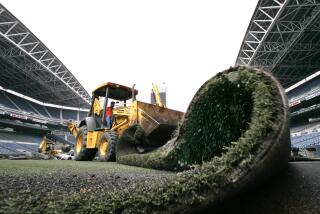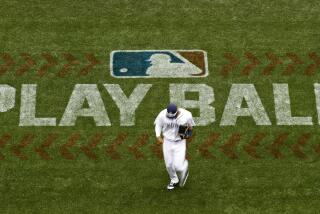Grass-Roots Games
- Share via
They say children change your life. They also change your yard.
“Clients are always telling me, ‘I’d have such a beautiful backyard if it wasn’t used as a soccer field after school,’ ” says landscape architect Keith Mallert of Santa Ana. “I just tell them that that’s what yards are for. Save your plans for the day they move out.”
Whether you’re dealing with hoop addicts, Little Leaguers or little ones, virtually any yard can be turned into a play area where skills can be honed and fun can be had.
Following is a look at ideas and some of the equipment available to turn your backyard into a field of dreams.
Pre-Peewees
Smaller children who aren’t ready to toss the ball around will still benefit from fresh air, and they can begin to develop motor and athletic skills with a playground set.
“Forts and slides are very popular,” says George Cowan of Swings ‘n Things in Laguna Hills. “The better-quality models made of cedar and redwood are designed to last. With the right landscaping, they can really add to the look of your yard.”
Flashy units can be costly ($200 and up), but you can build yard toys for less.
Corona del Mar native Ray Wallace has republished his classic “Backyard Things That Are Fun to Build!” ($12.95, Infotainment Publishing, [800] 205-8254), which details how to make spaceships, airplanes, castles and more with materials you’d find in most any garage.
“My brother and I received the book when we were young, and we spent many hours building and playing on the toys we built,” says co-publisher Gary Armstrong of Anaheim. “Part of the fun was building the projects together.”
General Care
To turn your backyard into a practice field, you’ll need a lawn that can take punishment. Ideally, a hybrid Bermuda grass is best, experts say. Stay clear of ryes or bluegrass.
“To keep the grass in top shape, you’ll need to water, fertilize and de-thatch it,” says Keith Newman of Country Garden Nursery in Placentia. “De-thatching is a [grass-thinning] process that’s done every three to four years to weed out the dead grass shoots.”
Even the hardiest lawn has problems surviving the trample of baserunning. When divots and low spots develop, keep them from getting worse by having a bag of sand or premium topsoil close by to fill them in.
“You’ll need to reseed or re-sod the damaged area, but if you stay on top of the problem, it won’t affect a wider area,” Newman says.
It’s important to move the bases or other equipment when not in use, or it can kill the grass underneath by blocking sunlight.
Baseball
Most Little Leaguers would love to wake up to a baseball diamond in the backyard. Although few homeowners have the space for a kid to round the bases, let alone hit a ball 200 feet, there are ways for budding Ken Griffey Jr.’s to work on their craft.
A pitching machine to help with batting skills isn’t a necessity (no matter what your child tells you), but it can help increase bat-to-ball coordination.
Moderately priced models ($150 and up) generally are positioned just ahead and to the side of the batter, and they drop balls from a chute into the batter’s range. They can be adjusted for the height of a batter as she grows up. It’s the same effect as tossing a ball up and taking a swing.
More expensive machines ($500 and up) work like those found in batting cages. The ball is hurled from a mechanical arm or spit from motorized spinning wheels. The result is a pitch that mimics a human throw. The super-deluxe models can throw both right- and left-handed curves, be pointed to the sky to simulate pop-ups for fielding practice and send up softballs for Mom and Dad to practice for their Tuesday night league.
Hardballs would be a little unwieldy for backyard use. The toss up-style machines work well with hard plastic balls, and rubber-coated or padded hardballs can be used for throwing machines.
Collecting all those hit balls could be quite an exercise without a net. Most range from $50 to $150, but with some netting and heavy-duty PVC tubing, one could be made for half the cost. A batting cage could probably be constructed from the same materials.
Creating a baserunning path is easy, veterans say. The distance between bases in Little League is 45 feet. Measure the distance, clear a path and set the bases. Make sure there’s nothing fragile behind the bases; otherwise an errant throw may do damage.
Building a regulation pitching mound is a little tougher. Instead of hauling in clay to create the 6-inch elevation needed in Little League play, you may want to establish the mound where there’s a slight hill in the yard.
The Little League distance between pitching rubber and home plate is 46 feet. Many sporting goods stores carry regulation home plates (around $20) and bases ($10).
Basketball
The old backboard with the rusty hoop is still a fixture on many driveways, but newer portable goals ($150 and up) allow movable play.
Generally consisting of a weighted base on rollers and a pole to adjust the height of the basket, these goals are perfect for areas such as a side yard, which is usually large enough for a workout but too small for a three-on-three game. When you have more players, move it to the driveway.
The portable goal is also CC&R-friendly.;
“Many people in planned communities [such as condominium and townhome complexes] aren’t allowed to put up a backboard on the front of their garage,” says Scott Hunt of Chick’s Sporting Goods in Yorba Linda. “These goals let you have fun without getting into trouble with your neighbors.”
Practice free throws by marking a line 15 feet directly out from the backboard. The lines marking the outside of the key are 12 feet across. If you have the width or length, try marking a 3-point line, a half-circle 22 feet from the basket, and see who has what it takes to make the pros.
Soccer
The recent successes of the World Cup and the new Major League soccer teams have fueled already burning interest in soccer in Southern California, especially among youths.
Fluorescent cones to mark the goal ($3-$5) are available at most sporting goods stores.
Or, create one with PVC framing and fabric netting, available at hardware stores. Although the width of the goal varies according to the division of play, the average is 14-feet wide by 6-feet high.
Golf
No, you’re probably not going to fit a driving range in the yard, but you might be able to work in a chipping green. A putting green is also possible, although maintaining one is almost a full-time job.
For the chipping area, keep the grass closely mowed and take care to replace divots and fill in holes with sand. Even though you will only be chipping, it would be easier on the turf if you use practice balls.
Although many golfers dream of a putting green in the backyard, it isn’t as easy as it looks. Even the simplest greens require grading and soil rehabilitation before you carefully grow hybrid Bermuda or lay sod; then the green needs meticulous watering, fertilizing and mowing. By mowing your Bermuda to 1/4-inch, you or your child can have a rough green that will at least give the feel of putting.
Once your yard is ready to train the next Tiger Woods, pull up a lawn chair and enjoy the action.
And just think: One day the yard will be yours again.






